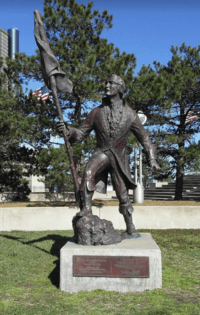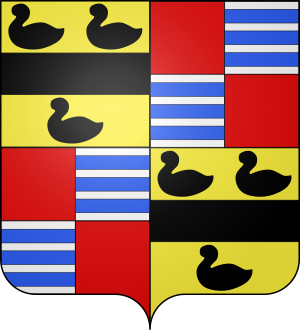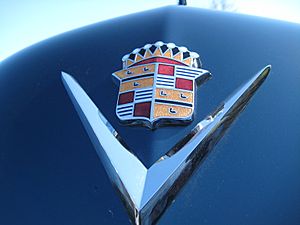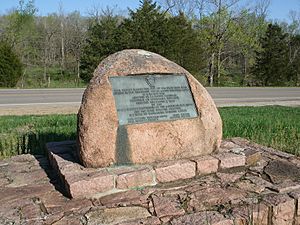Antoine de la Mothe Cadillac facts for kids
Quick facts for kids
Antoine de la Mothe,
sieur de Cadillac |
|
|---|---|

Statue of Cadillac in
Hart Plaza in Detroit, Michigan |
|
| 3rd French Colonial Governor of Louisiana | |
| In office 1713–1716 |
|
| Monarch | Louis XIV Louis XV |
| Preceded by | Jean-Baptiste Le Moyne de Bienville |
| Succeeded by | Jean-Baptiste Le Moyne de Bienville |
| Personal details | |
| Born |
Antoine Laumet
March 5, 1658 Saint-Nicolas-de-la-Grave, France |
| Died | October 16, 1730 (aged 72) Castelsarrasin, France |
| Resting place | Church of the Carmelite Fathers of Castelsarrasin |
| Spouse | Marie-Thérèse Guyon |
| Occupation | Governor, explorer, adventurer |
| Known for | Founder of Detroit |
| Signature |  |
| Military service | |
| Allegiance | |
| Branch/service | French Navy |
| Years of service | 1675–1718 |
| Awards | Order of Saint Louis Chevalier |
Antoine de la Mothe, sieur de Cadillac (born Antoine Laumet on March 5, 1658, in France) was a French explorer and adventurer. He played an important role in New France, a large area that stretched from Eastern Canada to Louisiana. He started as an explorer and fur trader in Acadia in 1683. Over time, he gained important political positions in the colony.
Cadillac became the commander of Fort de Buade in St. Ignace, Michigan, in 1694. Later, in 1701, he founded Fort Pontchartrain du Détroit, which grew into the city of Detroit. He was in charge of this fort until 1710. From 1710 to 1716, he served as the governor of Louisiana.
His detailed knowledge of the coasts of New England and the Great Lakes region was highly valued. This helped him gain favor with important leaders like Frontenac, the governor of New France, and Pontchartrain, who was in charge of the Navy. He even received the Order of Saint Louis from King Louis XIV.
When he arrived in America, Antoine Laumet chose the name "Cadillac" after a town in France. The city of Detroit later became famous for making cars. In 1902, William H. Murphy and Henry M. Leland started the Cadillac auto company. They honored him by using his name for their company and his personal coat of arms as their logo. Many places in America are named after him, including Cadillac Mountain in Maine and the town of Cadillac, Michigan.
For a long time, Cadillac was seen as a hero. However, some recent historians have looked at his actions more closely. They suggest that he faced many challenges and disagreements during his time in New France.
Contents
Antoine Cadillac's Early Life
Antoine Laumet was born on March 5, 1658, in a small town called Saint-Nicolas-de-la-Grave in France. His father, Jean Laumet, was a lawyer. In 1652, his father was appointed as a judge in Saint-Nicolas-de-la-Grave. Antoine's mother, Jeanne Péchagut, came from a family of merchants and landowners.
Antoine's letters from his adult life show that he studied hard at a Jesuit school. There, he learned about religion, law, farming, plants, and animals.
In 1675, when he was 17, Antoine said he joined the military as a cadet. Later, he wrote that he had been an officer in different regiments.
When he was 25, Antoine Laumet left France for the New World. His family had faced some financial problems. He may have left France without being officially listed on any ship's passenger list.
Adventures in New France
In 1683, Antoine Laumet arrived at Port Royal, the main city of Acadia. For the next four years, he explored his new home. He traveled to New England and even as far south as the Carolinas. He also learned some languages and customs of the Native American tribes.
He likely started working with Denis Guyon, a merchant from Quebec. On June 25, 1687, Antoine married Guyon's 17-year-old daughter, Marie-Thérèse, in Quebec.
This marriage certificate is the first time his new name appeared. He called himself "Antoine de Lamothe, écuyer, sieur de Cadillac." Many people who moved to the New World created new identities. Antoine likely did this to start fresh. He chose his new name from places and people his family knew in France. He used the title écuyer (squire) and sieur (sire) of Cadillac. This helped him create a new identity and a noble background.
He even designed his own coat of arms. It combined symbols from families connected to his new name.
Antoine and Marie-Thérèse had a large family. They had six daughters and seven sons.
Exploring and Serving the King
In 1688, Cadillac was given control of a large estate called Les Douacques. This area later became the tourist town of Bar Harbor, Maine. However, the estate did not bring him much money. He started trading with officers in Port Royal.
In 1689, he went on an expedition near Boston. When he returned, he asked for a job as a notary, but his request was turned down. Then, he met Governor Louis de Buade de Frontenac in Quebec. Frontenac sent him on an exploration mission along the New England coast.
In 1690, Cadillac traveled to Paris, France. He became close to important government officials. He was appointed an officer in the marine troops. When he returned to Port Royal, he found that the English had taken the city. His wife, daughter, and son were held captive. They were later released in exchange for English prisoners. In 1691, Cadillac moved his family to Quebec. But their ship was attacked, and they lost all their belongings.
Cadillac was promoted to lieutenant in 1692. He was sent with a mapmaker to create maps of the New England coastline. These maps were for a possible French attack on the English colonies. He went back to France to give his maps and report to the Secretary of State, Pontchartrain. In 1693, he received money for his work and was sent on another mission. Frontenac promoted him to captain, then to lieutenant commander in 1694.
Michilimackinac: A Fur Trading Hub (1694–1696)
Cadillac was put in charge of all the trading posts in the Pays d'En-Haut (the upper countries). He took command of Fort de Buade, also known as Michilimackinac. This fort controlled all the fur trading in a vast area, including the Missouri, Mississippi, Great Lakes, and Ohio valleys.
In 1695, Cadillac explored the Great Lakes area and made maps. He thought it would be a good idea to build a new fort in the narrow passage between Lake Erie and Lake Huron. This fort would help the French compete with the English.
In 1696, the king ordered all trading posts, including Michilimackinac, to close. This was done to help with problems in the fur trade. Cadillac then returned to Montreal. He later got permission to go back to France to propose his idea for a new fort. Many people in Canada were against his plan. They thought it would harm Quebec and Montreal. But in 1699, Cadillac finally got support for his new fort. The king approved it in 1700 and put Cadillac in charge.
Founding Detroit (1701–1710)
On July 24, 1701, Antoine de La Mothe-Cadillac founded Fort Pontchartrain and the parish of Sainte-Anne. These were located on the narrow passage, which the French called "le détroit" (the strait). He was helped by Alphonse de Tonti. Their wives joined them in October.
In 1702, Cadillac went back to Quebec. He asked for control over all fur-trading activities and the Native American tribes in the area. He also became a shareholder in a trading company. After returning to the strait, he helped welcome and settle Native American tribes who had moved from Michilimackinac.
In 1703, a fire destroyed Fort Pontchartrain. All the records were lost. In 1704, Cadillac was called back to Quebec because of disagreements about fur trading. He was held for a few months, but his name was cleared in 1705. The king confirmed his titles and gave him the fur-trading control he wanted.
Two years later, Cadillac faced more complaints about his leadership. Pontchartrain sent someone to investigate. In 1708, a report was made against Cadillac.
In 1709, the soldiers at the strait were ordered to return to Montreal. In 1710, the king named Cadillac governor of La Louisiane, a huge territory. He was told to go there right away by traveling down the Mississippi River.
Governor of Louisiana (1710–1716)
Cadillac did not go to Louisiana immediately. He first made a list of everything at the strait. Then, in 1711, he sailed to France with his family. In Paris, in 1712, he convinced a rich businessman named Antoine Crozat to invest in Louisiana.
In June 1713, the Cadillac family finally arrived at Fort Louis, Louisiana (now Mobile, Alabama). It was a difficult journey. In 1714, Crozat suggested building forts along the Mississippi River. Cadillac, however, wanted to strengthen defenses at the mouth of the river and trade with nearby Spanish colonies.
In 1715, Cadillac and his son Joseph explored the Illinois Country (Upper Louisiana). They claimed to have found a copper mine, though there is no copper ore there. They started a farm and founded the settlement of St. Philippe. Cadillac also directed the first mining of lead in what is now Missouri. This place is called Mine La Motte. The French brought in enslaved people to work at the mine. The lead was important for making ammunition. The area is still a major source of lead today.
After many disagreements, Crozat removed Cadillac from his position in the company. The next year, Cadillac was removed from his colonial office.
Life in Castelsarrasin (1717–1730)
The Cadillac family returned to France in 1717 and settled in La Rochelle. Cadillac went to Paris with his son Joseph. They were held for five months. They were released in 1718, and Cadillac received the Order of Saint Louis for his 30 years of service. He moved back to his family home to manage his parents' estate.
He also made many trips to Paris to get his rights to the land at the strait recognized. He finally succeeded in 1722. He sold his estate at the strait to Jacques Baudry de Lamarche. The French government then appointed Cadillac as governor and mayor of Castelsarrasin, a town near where he was born.
Antoine de Lamothe-Cadillac passed away on October 16, 1730, in Castelsarrasin, at the age of 72. He was buried in a church vault there.
Cadillac's Lasting Legacy
Some of Antoine de Lamothe-Cadillac's big ideas were put into action after he left New France. For example, Jean-Baptiste Le Moyne de Bienville founded the city of New Orleans in 1718. It became a very important port and city for New France.
The strait where Detroit was founded became a very important place. Fort Pontchartrain du Détroit was in a perfect spot between the Great Lakes and the river systems. Other forts, like Fort Detroit and Fort Wayne, were built there later.
The famous car brand Cadillac was named after him. Its main office was in Detroit, the city Cadillac helped found.
Antoine de la Mothe Cadillac was honored with a 3-cent postage stamp on July 24, 1951. This stamp celebrated the 250th anniversary of his arrival in Detroit in 1701. The stamp shows Detroit's skyline in 1951 and Cadillac landing there in 1701.
On April 20, 2016, a public high school in Windsor, Ontario, Canada, was renamed in Cadillac's honor.
In the early 1900s, a street in Montreal, Canada, was named after Cadillac. In 1976, the Cadillac station on the Montreal Metro subway system opened on this street.
Images for kids
See also
 In Spanish: Antoine de Lamothe-Cadillac para niños
In Spanish: Antoine de Lamothe-Cadillac para niños






